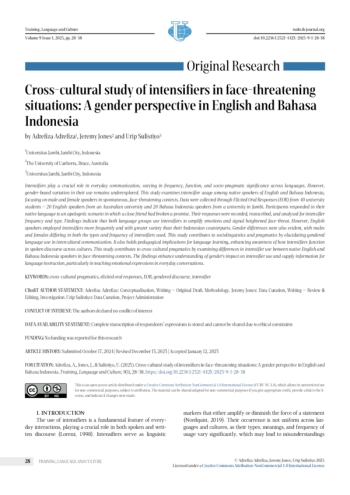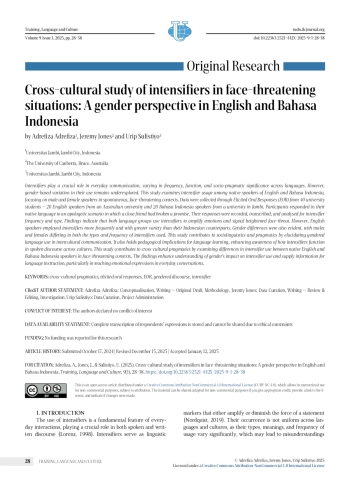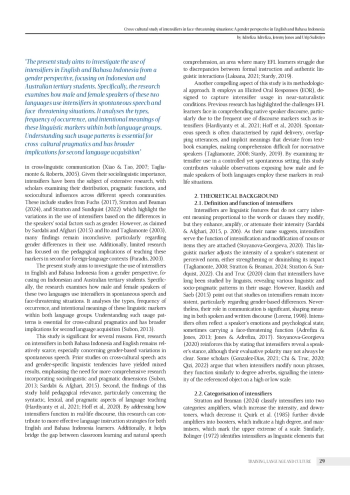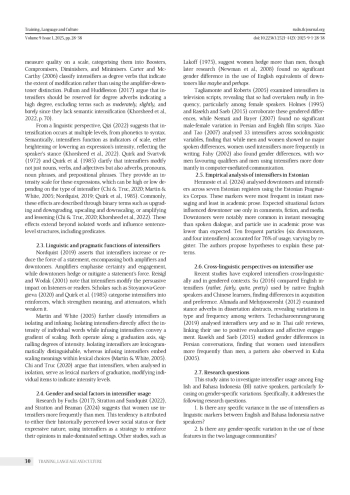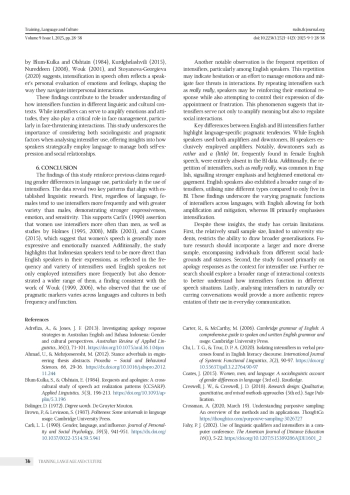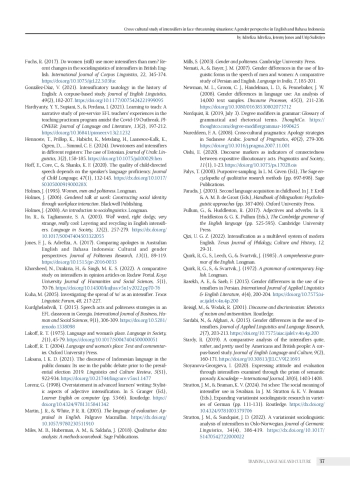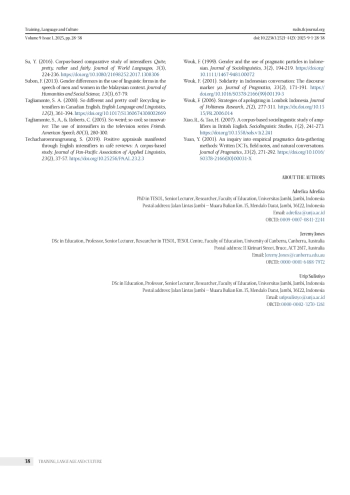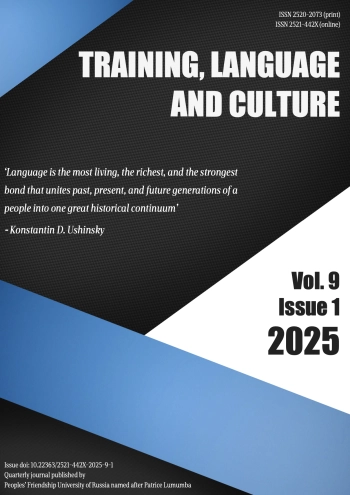Intensifiers play a crucial role in everyday communication, varying in frequency, function, and socio-pragmatic significance across languages. However, gender-based variation in their use remains underexplored. This study examines intensifier usage among native speakers of English and Bahasa Indonesia, focusing on male and female speakers in spontaneous, face-threatening contexts. Data were collected through Elicited Oral Responses (EOR) from 40 university students – 20 English speakers from an Australian university and 20 Bahasa Indonesia speakers from a university in Jambi. Participants responded in their native language to an apologetic scenario in which a close friend had broken a promise. Their responses were recorded, transcribed, and analysed for intensifier frequency and type. Findings indicate that both language groups use intensifiers to amplify emotions and signal heightened face-threat. However, English speakers employed intensifiers more frequently and with greater variety than their Indonesian counterparts. Gender differences were also evident, with males and females differing in both the types and frequency of intensifiers used. This study contributes to sociolinguistics and pragmatics by elucidating gendered language use in intercultural communication. It also holds pedagogical implications for language learning, enhancing awareness of how intensifiers function in spoken discourse across cultures. This study contributes to cross-cultural pragmatics by examining differences in intensifier use between native English and Bahasa Indonesia speakers in face-threatening contexts. The findings enhance understanding of gender’s impact on intensifier use and supply information for language instruction, particularly in teaching emotional expressions in everyday conversations.
Идентификаторы и классификаторы
The use of intensifiers is a fundamental feature of everyday interactions, playing a crucial role in both spoken and written discourse (Lorenz, 1998).
Список литературы
1. Adrefiza, A., & Jones, J. F. (2013). Investigating apology response strategies in Australian English and Bahasa Indonesia: Gender and cultural perspectives. Australian Review of Applied Linguistics, 36(1), 71-101. DOI: 10.1075/aral.36.1.04jon
2. Ahmad, U., & Mehrjooseresht, M. (2012). Stance adverbials in engineering thesis abstracts. Procedia - Social and Behavioral Sciences, 66, 29-36. DOI: 10.1016/j.sbspro.2012.11.244
3. Blum-Kulka, S., & Olshtain, E. (1984). Requests and apologies: A cross-cultural study of speech act realization patterns (CCSARP). Applied Linguistics, 5(3), 196-213. DOI: 10.1093/applin/5.3.196
4. Bolinger, D. (1972). Degree words. De Gruyter Mouton.
5. Brown, P., & Levinson, S. (1987). Politeness: Some universals in language usage. Cambridge University Press.
6. Carli, L. L. (1990). Gender, language, and influence. Journal of Personality and Social Psychology, 59(5), 941-951. DOI: 10.1037/0022-3514.59.5.941 EDN: HIUQET
7. Carter, R., & McCarthy, M. (2006). Cambridge grammar of English: A comprehensive guide to spoken and written English grammar and usage. Cambridge University Press.
8. Chi, L. T. G., & Truc, D. P. A. (2020). Isolating intensifiers in verbal processes found in English literacy discourse. International Journal of Systemic Functional Linguistics, 3(2), 90-97. DOI: 10.55637/ijsfl.3.2.2764.90-97 EDN: TBQVBD
9. Coates, J. (2015). Women, men, and language: A sociolinguistic account of gender differences in language (3rd ed.). Routledge.
10. Creswell, J. W., & Creswell, J. D. (2018). Research design: Qualitative, quantitative, and mixed methods approaches (5th ed.). Sage Publication.
11. Crossman, A. (2020, March 19). Understanding purposive sampling: An overview of the methods and its applications. ThoughtCo. https://thoughtco.com/purposive-sampling-3026727.
12. Fahy, P. J. (2002). Use of linguistic qualifiers and intensifiers in a computer conference. The American Journal of Distance Education 16(1), 5-22. DOI: 10.1207/S15389286AJDE1601_2
13. Fuchs, R. (2017). Do women (still) use more intensifiers than men? Recent changes in the sociolinguistics of intensifiers in British English. International Journal of Corpus Linguistics, 22, 345-374. DOI: 10.1075/ijcl.22.3.03fuc
14. González-Díaz, V. (2021). Intensificatory tautology in the history of English: A corpuse-based study. Journal of English Linguistics, 49(2), 182-207. DOI: 10.1177/0075424221999095 EDN: MXFBTQ
15. Hardiyanty, Y. Y., Supiani, S., & Perdana, I. (2021). Learning to teach: A narrative study of pre-service EFL teachers’ experiences in the teaching practicum program amidst the Covid-19 Outbreak. PIONEER: Journal of Language and Literature, 13(2), 197-212. DOI: 10.36841/pioneer.v13i2.1232
16. Hennoste, T., Prillop, K., Habicht, K., Metslang, H., Laanesoo-Kalk, K., Ogren, D., … Simmul, C. E. (2024). Downtoners and intensifiers in different registers: The case of Estonian. Journal of Uralic Linguistics, 3(2), 158-185. DOI: 10.1075/jul.00029.hen
17. Hoff, E., Core, C., & Shanks, K. F. (2020). The quality of child-directed speech depends on the speaker’s language proficiency. Journal of Child Language, 47(1), 132-145. DOI: 10.1017/S030500091900028X
18. Holmes, J. (1995). Women, men and politeness. Longman.
19. Holmes, J. (2006). Gendered talk at work: Constructing social identity through workplace interaction. Blackwell Publishing.
20. Holmes, J. (2008). An introduction to sociolinguistics. Longman.
21. Ito, R., & Tagliamonte, S. A. (2003). Well weird, right dodgy, very strange, really cool: Layering and recycling in English intensifiers. Language in Society, 32(2), 257-279. DOI: 10.1017/S0047404503322055 EDN: FOISIL
22. Jones, F. J., & Adrefiza, A. (2017). Comparing apologies in Australian English and Bahasa Indonesia: Cultural and gender perspectives. Journal of Politeness Research, 13(1), 89-119. DOI: 10.1515/pr-2016-0033
23. Khorsheed, N., Dzakiria, H., & Singh, M. K. S. (2022). A comparative study on intensifiers in opinion articles on Rudaw Portal. Koya University Journal of Humanities and Social Sciences, 5(1), 70-76. DOI: 10.14500/kujhss.v5n1y2022.pp70-76 EDN: SPLPCY
24. Kuha, M. (2005). Investigating the spread of ‘so’ as an intensifier. Texas Linguistic Forum, 48, 217-227.
25. Kurdghelashvili, T. (2015). Speech acts and politeness strategies in an EFL classroom in Georgia. International Journal of Business, Human and Social Sciences, 9(1), 306-309. DOI: 10.5281/zenodo.1338098
26. Lakoff, R. T. (1975). Language and woman’s place. Language in Society, 2(1), 45-79. DOI: 10.1017/S0047404500000051
27. Lakoff, R. T. (2004). Language and woman’s place: Text and commentaries. Oxford University Press.
28. Laksana, I. K. D. (2021). The discourse of Indonesian language in the public domain: Its use in the public debate prior to the presidential election 2019. Linguistics and Culture Review, 5(S1), 922-934. DOI: 10.21744/lingcure.v5ns1.1477 EDN: TAQWWV
29. Lorenz, G. (1998). Overstatement in advanced learners’ writing: Stylistic aspects of adjective intensification. In S. Granger (Ed.), Learner English on computer (pp. 53-66). Routledge. DOI: 10.4324/9781315841342
30. Martin, J. R., & White, P. R. R. (2005). The language of evaluation: Appraisal in English. Palgrave Macmillan. DOI: 10.1057/9780230511910
31. Miles, M. B., Huberman, A. M., & Saldaña, J. (2018). Qualitative data analysis: A methods sourcebook. Sage Publications.
32. Mills, S. (2003). Gender and politeness. Cambridge University Press.
33. Nemati, A., & Bayer, J. M. (2007). Gender differences in the use of linguistic forms in the speech of men and women: A comparative study of Persian and English. Language in India, 7, 185-201.
34. Newman, M. L., Groom, C. J., Handelman, L. D., & Pennebaker, J. W. (2008). Gender differences in language use: An analysis of 14,000 text samples. Discourse Processes, 45(3), 211-236. DOI: 10.1080/01638530802073712
35. Nordquist, R. (2019, July 3). Degree modifiers in grammar: Glossary of grammatical and rhetorical terms. ThoughtCo. https://thoughtco.com/degree-modifiergrammar-1690425.
36. Nureddeen, F. A. (2008). Cross-cultural pragmatics: Apology strategies in Sudanese Arabic. Journal of Pragmatics, 40(2), 279-306. DOI: 10.1016/j.pragma.2007.11.001
37. Oishi, E. (2020). Discourse markers as indicators of connectedness between expositive illocutionary acts. Pragmatics and Society, 11(1), 1-23. DOI: 10.1075/ps.17028.ois EDN: TQTPED
38. Palys, T. (2008). Purposive sampling. In L. M. Given (Ed.), The Sage encyclopedia of qualitative research methods (pp. 697-698). Sage Publications.
39. Paradis, J. (2003). Second language acquisition in childhood. In J. F. Kroll & A. M. B. de Groot (Eds.), Handbook of bilingualism: Psycholinguistic approaches (pp. 387-406). Oxford University Press.
40. Pullum, G., & Huddleston, R. (2017). Adjectives and adverbs. In R. Huddleston & G. K. Pullum (Eds.), The Cambridge grammar of the English language (pp. 525-595). Cambridge University Press.
41. Qizi, U. G. Z. (2022). Intensification as a multilevel system of modern English. Texas Journal of Philology, Culture and History, 12, 29-31.
42. Quirk, R, G., S., Leech, G., & Svartvik, J. (1985). A comprehensive grammar of the English. Longman.
43. Quirk, R, G., S., & Svartvik, J. (1972). A grammar of contemporary English. Longman.
44. Rasekh, A. E., & Saeb, F. (2015). Gender differences in the use of intensifiers in Persian. International Journal of Applied Linguistics & English Literature, 4(4), 200-204. DOI: 10.7575/aiac.ijalel.v.4n.4p.200
45. Reisigl, M., & Wodak, R. (2001). Discourse and discrimination: Rhetorics of racism and antisemitism. Routledge.
46. Sardabi, N., & Afghari, A. (2015). Gender differences in the use of intensifiers. Journal of Applied Linguistics and Language Research, 2(7), 203-213. DOI: 10.7575/aiac.ijalel.v.4n.4p.200
47. Stardy, R. (2019). A comparative analysis of the intensifiers quite, rather, and pretty used by Americans and British people: A corpus-based study. Journal of English Language and Culture, 9(2), 160-171. DOI: 10.30813/JELC.V9I2.1693
48. Stoyanova-Georgieva, I. (2020). Expressing attitude and evaluation through intensifiers examined through the prism of semantic prosody. Knowledge - International Journal, 38(6), 1403-1408.
49. Stratton, J. M., & Beaman, K. V. (2024). Fei schee: The social meaning of intensifier use in Swabian. In J. M. Stratton & K. V. Beaman (Eds.), Expanding variationist sociolinguistic research in varieties of German (pp. 111-131). Routledge. DOI: 10.4324/9781003379706
50. Stratton, J. M., & Sundquist, J. D. (2022). A variationist sociolinguistic analysis of intensifiers in Oslo-Norwegian. Journal of Germanic Linguistics, 34(4), 386-419. DOI: 10.1017/S1470542722000022 EDN: IAHAGH
51. Su, Y. (2016). Corpus-based comparative study of intensifiers: Quite, pretty, rather and fairly. Journal of World Languages, 3(3), 224-236. DOI: 10.1080/21698252.2017.1308306
52. Subon, F. (2013). Gender differences in the use of linguistic forms in the speech of men and women in the Malaysian context. Journal of Humanities and Social Science, 13(3), 67-79.
53. Tagliamonte, S. A. (2008). So different and pretty cool! Recycling intensifiers in Canadian English. English Language and Linguistics, 12(2), 361-394. DOI: 10.1017/S1360674308002669
54. Tagliamonte, S., A., & Roberts, C. (2005). So weird; so cool; so innovative: The use of intensifiers in the television series Friends. American Speech, 80(3), 280-300.
55. Techacharoenrungrueang, S. (2019). Positive appraisals manifested through English intensifiers in café reviews: A corpus-based study. Journal of Pan-Pacific Association of Applied Linguistics, 23(2), 37-57. DOI: 10.25256/PAAL.23.2.3
56. Wouk, F. (1999). Gender and the use of pragmatic particles in Indonesian. Journal of Sociolinguistics, 3(2), 194-219. DOI: 10.1111/1467-9481.00072
57. Wouk, F. (2001). Solidarity in Indonesian conversation: The discourse marker ya. Journal of Pragmatics, 33(2), 171-191. DOI: 10.1016/S0378-2166(99)00139-3 EDN: AMFEEJ
58. Wouk, F. (2006). Strategies of apologizing in Lombok Indonesia. Journal of Politeness Research, 2(2), 277-311. DOI: 10.1515/PR.2006.014
59. Xiao, R., & Tao, H. (2007). A corpus-based sociolinguistic study of amplifiers in British English. Sociolinguistic Studies, 1(2), 241-273. DOI: 10.1558/sols.v1i2.241
60. Yuan, Y. (2001). An inquiry into empirical pragmatics data-gathering methods: Written DCTs, field notes, and natural conversations. Journal of Pragmatics, 33(2), 271-292. DOI: 10.1016/S0378-2166(00)00031-X
Выпуск
Другие статьи выпуска
In a thirty-year career as a teacher of English as a foreign and second language, Nik Peachey set up his own online system for producing weekly lesson plans for teachers, focusing on social issues and addressing areas of language use of special value to language teachers wanting to introduce new topics and activities to their classes at different levels of proficiency. Like many of his colleagues, he has moved beyond the use of the computer and the Internet to produce and circulate lesson plans and now has published an online book on the role of artificial intelligence and its applications, such as ChatGPT, in language learning and teaching. Entitled The Manual of AI-Mediated Autonomous Teacher Development, the book is available online. Nik Peachey takes teachers of English through the theory and practice of artificial intelligence in a clear, simple and non-scientific approach which is adaptable to all teachers of foreign and second languages helping them create and develop new teaching materials to interest and involve their students in the learning process.
The study aims to examine how movie titles are translated from English to Vietnamese under the light of the translation methods proposed by Newmark (1988). To fulfil this research objective, the researcher uses a linguistic corpus consisting of 83 pairs of movie titles collected randomly from various sources. Two research methods are employed, including discourse analysis to analyse the linguistic components used in the original and translated titles and translation comparative to compare the linguistic and semantic similarities and differences between the two versions to identify what methods have been used in each title translation. The research findings show that of the eight methods presented by Newmark (1988), only five are employed, including faithful translation, semantic translation, idiomatic translation, free translation and adaptation, together with the two additional ones, including keeping the title unchanged and creating a new title, of which faithful translation has the highest frequency of use, while the least common method is idiomatic translation. The findings indicate that the choice of translation methods depends on the text types and translators’ consideration of the linguistic, semantic and pragmatic transfer in the translation process. These findings partly align with the earlier research of Newmark and other scholars, thereby further consolidating the theories related to translation methods while some new findings are identified as the contributions of this study to the research topic. Based on the findings, some implications have been made on how to translate movie titles in general and other text types in particular.
The evolution of musical terminology is a dynamic process influenced by historical, linguistic and social factors. While initially confined to professional discourse, musical terms have been increasingly used in non-professional contexts, necessitating further investigation into this phenomenon. This study aims to analyse the development of English musical terminology, focusing on its transformation from specialised technical vocabulary to broader cultural and communicative usage. The research employs a combination of comparative-historical analysis, textual analysis and lexicographic examination. Drawing upon sources including seminal works by Charles Ives, Charles Stanford, John Mauceri and Norman Lebrecht, the study explores how musical terms function across genres and registers. The findings reveal three primary categories of musical terms: universal, unique and author. Universal terms maintain consistent meanings across musical traditions, unique terms emerge from specific musical schools and authorial terms reflect individual creativity. The research also highlights how determinologisation and dissemination processes influence the reinterpretation of musical terms in non-professional texts. The implications of this study emphasise the dynamic role of musical terminology as a bridge between professional and non-professional communication, implying its significance in both linguistic theory and global culture. The findings contribute to a deeper understanding of terminological adaptation in evolving communicative landscapes and pave the way to further research into the role of musical terms in interdisciplinary contexts.
Anxiety is a multifaceted phenomenon that necessitates a systematic approach to its examination by delving deeper into the experiences of those who encounter it. The study used a mixed method design to address teacher anxiety by employing questionnaires, interviews, and classroom observations based on Horwitz’s (1996) Foreign Language Teacher Anxiety Scale (FLTAS). First, the questionnaire was used to collect data. Second, interviews were conducted. Third, the observation phase took place. The study participants were 240 English language teachers (110 female and 130 male) with 2 to 5 years of experience at the tertiary level. Quantitative results indicate a great degree of teacher anxiety. Male teachers, on average, report a higher anxiety level than female counterparts on the FLTAS. As 0.000975 < 0.05, the p-value indicates that there is a statistically significant difference in mean scores between female and male teachers’ anxiety. Interviews revealed that English teachers experienced anxiety for various reasons, including unprepared lessons and a lack of language proficiency, fear of negative evaluation, a sense of unpreparedness for class, anxiety about making mistakes, the challenges faced by language teachers in managing the classroom, and uncertainty about language skills. An analysis of classroom observations from 10 classes yielded that most teachers harboured apprehension about being observed, struggled to manage a large number of students in their English classes, ranging from 150 to 250 students, spoke at a rapid pace, and frequently employed the technique of avoiding student inquiries during the teaching process. The current research concludes with future recommendations to minimise teacher anxiety in teaching practices by engaging them in pre and post-professional training.
This study investigates the role of deictic expressions in the IELTS speaking test, addressing a gap in research on how test-takers across proficiency levels use deixis in spoken language assessment. While previous studies have examined general discourse features in language testing, little attention has been given to the frequency, functions, and distribution of deixis in assessing spoken proficiency. The study analysed a corpus of 30 IELTS speaking test transcripts, covering proficiency levels from low-intermediate to advanced. Using Levinson’s classification of deixis, the study employed quantitative frequency analysis and qualitative discourse analysis to examine variations in the use of personal, temporal, and spatial deixis. The findings revealed that personal deixis was the most frequently used, followed by temporal and spatial deixis. However, the results of One-Way ANOVA test showed no significant differences in deixis usage across proficiency levels. These findings contribute to English language teaching and assessment by highlighting how deixis functions in test-taker discourse, offering insights for IELTS preparation and speaking proficiency evaluation. The study indicates the need for further exploration of discourse features in language assessment.
English for Academic Purposes (EAP) courses in Bangladeshi private universities are positioned to equip non-native undergraduate students with the required academic language skills needed for English Medium Instruction (EMI) education. However, these courses have frequently adopted generic language proficiency models, neglecting students’ academic and disciplinary literacy needs. Moreover, the paucity of studies on EAP leaves a critical lapse in understanding what changes are required, given this misalignment. Guided by Brown’s Needs Analysis framework (2016), this qualitative study investigated non-native undergraduate students’ perceptions and experiences of EAP courses at a Bangladeshi private university offering EMI education, focusing on its method of instruction, the barriers they face and the alignment of its content with their academic and professional needs. Thematic analysis of forty-five semi-structured interviews and document analysis of EAP course syllabi revealed a misalignment between current EAP courses and students’ academic and professional needs. The development of academic writing for disciplinary courses is unfulfilled, suggesting a need for a more targeted EAP curriculum. The study identifies students’ needs as systemic failures rather than linguistic deficits and challenges the generic EAP implementation in non-native higher education contexts like Bangladesh. It concludes that context-driven curricular reform, incorporation of skill-oriented content, and enhanced pedagogic practices can make current EAP courses to be needs-responsive. Additionally, teacher training in discipline-specific pedagogy is crucial for an equitable EAP redesign as it would better align with non-native students’ academic language and professional needs.
English is the dominant medium of instruction for numerous university programmes across the Arab Gulf. While a growing body of research examines learners’ attitudes towards English Medium Instruction (EMI), issues of language preference/use have received far less attention. The research reported here sought to redress this imbalance by examining the domain-based language preferences, use, and beliefs of English majors at Oman’s national university. A mixed methods approach was employed involving the administration of a 35-item questionnaire to 120 English majors and one-on-one semi-structured interviews with 13 participants. Descriptive analysis, Pearson’s chi-squared test, and Cramer’s V test were used to examine questionnaire data, while interview transcripts were analysed thematically before data triangulation was performed. Findings indicate respondents preferred and used English for academics and intended careers, Arabic for familial interactions, and both English and Arabic or English by itself to talk about feelings and beliefs. English and Arabic were almost equally preferred for identity representation, with a significant minority of respondents expressing a desire to study their majors in Arabic. Although gender and English proficiency were not found to be related to beliefs about language importance, Arabic proficiency had a moderate, statistically significant association. Arab students employing English to express cultural beliefs and identities has not been widely reported in the existing literature. Results suggest that, despite evidence of emerging bilingualism in some domains, reform to tertiary-level language of instruction policies and planning in the region and similar contexts worldwide, including by offering Arabic Medium Instruction options, may be necessary to ensure effective education provision.
The present study presents a comparative analysis of the translation processes and outcomes of human translators, Neural Machine Translation (NMT) systems and Large Language Models (LLMs) focusing on the translation of Metaphor-related Words (MRW). The study employs various research methodologies, including product analysis, think-aloud protocols, subsequent interviews, and translation quality assessments to uncover the choice of strategies in translating MRWs by different subject groups as well as its relation with quality criterion. Human translators and LLMs tend to favour strategies such as metaphor into different metaphor (M-M2) and metaphor reduction (M→Non), while NMT systems prefer the reproduction of metaphors (M→M). LLMs demonstrate translation patterns which are more aligned with human translators, helping them achieve higher evaluation scores, though their performance remains inconsistent, particularly with novel metaphors. Additionally, human translators process metaphors by incorporating conceptual, cultural, and contextual factors, whereas LLMs tend to rely on paraphrastic approaches. Evaluation results indicate that LLMs exhibit proficiency on par with novice translators in terms of accuracy, idiomatic expression, and vividness in metaphor translation, while NMT systems fall slightly short. The study highlights the influence of translation strategies on the quality of metaphor translation and concludes that, while NMT systems and LLMs can achieve performance comparable to human translators, much larger metaphor-specific datasets supported studies are expected to validate its consistency.
Статистика статьи
Статистика просмотров за 2025 год.
Издательство
- Издательство
- РУДН
- Регион
- Россия, Москва
- Почтовый адрес
- 117198, г. Москва, ул. Миклухо-Маклая, д. 6
- Юр. адрес
- 117198, г Москва, Обручевский р-н, ул Миклухо-Маклая, д 6
- ФИО
- Ястребов Олег Александрович (РЕКТОР)
- E-mail адрес
- rector@rudn.ru
- Контактный телефон
- +7 (495) 4347027
- Сайт
- https://www.rudn.ru/
